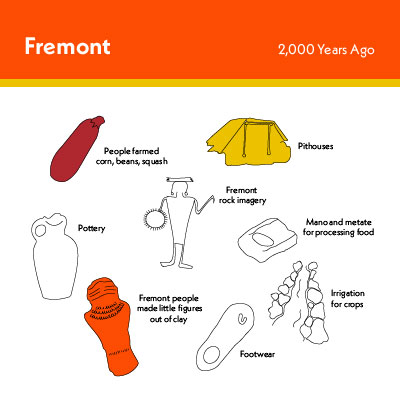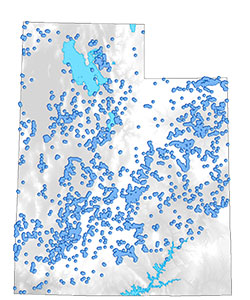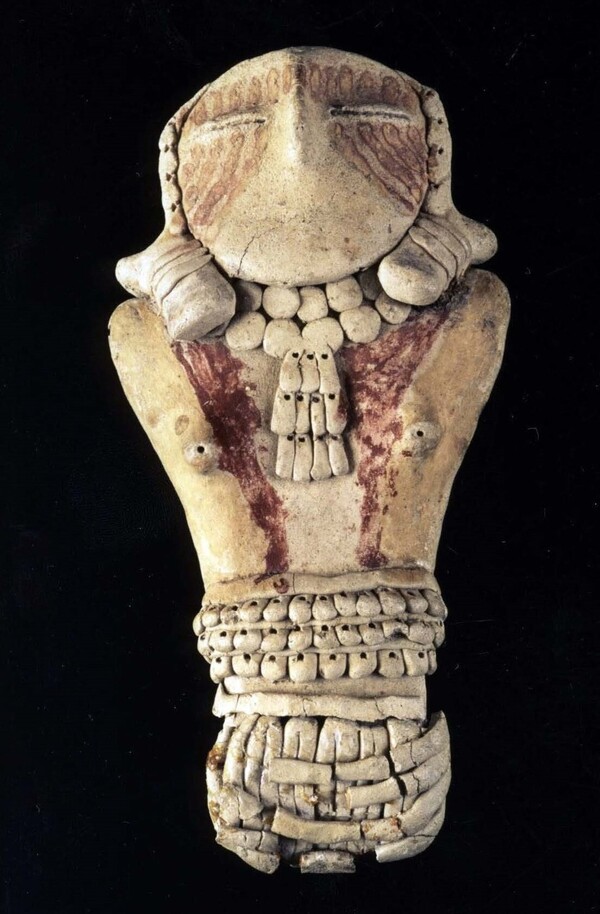By Savanna Agardy
500 BC — 1250 AD

Changes during the Late Archaic period brought a new way of living for Utah’s Indigenous peoples — one that included farming. During the Prehistoric Period, both Fremont and Ancestral Puebloan people lived in Utah. They shared some similarities, such as farming, but they lived in different environments and had different cultures. Fremont people lived in Central and Northern Utah — an area called the Great Basin. Ancestral Puebloan people lived in southern Utah, Nevada, Arizona, and New Mexico, in a region called the Colorado Plateau.
Fremont-era People

Farming was introduced in the Great Basin region around 500 BC (more than 2,000 years ago!) People living in what is now Arizona and New Mexico brought corn (maize), beans, and squash to Utah. During the Fremont era, people living in Northern and Central Utah began growing these crops to supplement their diet. They still also relied on traditional hunting and gathering for meat and other plants. However, farming caused people to stay in places longer in order to tend to their crops. Fremont-era people became less mobile than Archaic and Paleoindian peoples before them.
Because of this lifestyle change, Fremont-era people built permanent structures to live in, called pithouses. Pithouses were partially underground, which provided natural heating and cooling to keep the temperatures comfortable. Some Fremont-era people also lived in villages, with clusters of pithouses and storage units built next to each other – similar to how our neighborhoods are organized today.
Believe it or not, large Fremont communities used to live on the Wasatch Front, where cities like Salt Lake and Provo are today! The rivers from the mountains and Utah Lake made it a good place for Fremont people to live and farm. Fremont people even made irrigation systems to water their crops, which is a very advanced practice. Many people believe that Euro Americans were the first people to farm in Central and Northern Utah, but that is not true. Fremont people who came hundreds of years before them were expert farmers and made delicious meals of corn, beans, and squash, enriched by meat and wild plants.

Many Fremont Cultures
Not all Fremont communities were the same. Across Northern and Central Utah, there was a lot of variety in the ways Fremont-era people lived, including their culture. Depending on the local environment and available resources, communities relied on the foodways that could best sustain their families. Some groups supported themselves almost entirely through hunting, gathering, and fishing. Others lived in large villages near the Great Salt Lake and Utah Lake, and relied more on farming.
Archaeologists believe that there were large differences in culture and languages across the Fremont period. Nevertheless, the tools and technologies that people used during this time, the pithouse villages they left behind, and the rock art they carved across this region are all similar in style.

End of the Fremont Period
The Fremont way of living ended around 1250 AD. Some Fremont people changed their lifestyles, and others migrated out of Utah. This marked the end of the Fremont Period.
There are several reasons why these changes happened. A 50-year drought occurred around 1250 AD, which made it difficult for people to continue farming corn, beans, and squash. This environmental change led people to rely more on hunting and gathering, and to begin traveling across the landscape again. People also migrated out of Utah, finding new homes to the north or west. At the same time, new Native American people began migrating into Utah, such as the Navajo (Dine). Some archaeologists believe that Fremont people may have joined these newcomers to Utah and helped to create new Indigenous cultures.
While Fremont people were moving and changing in Northern and Central Utah, so were the Ancestral Puebloan people in the South. As the farming lifestyles of the Fremont Period ended, a new era began. This era is called the Late Prehistoric.
Keep Exploring!
Return to the First Peoples page here.
Return to the I Love Utah History home page here.